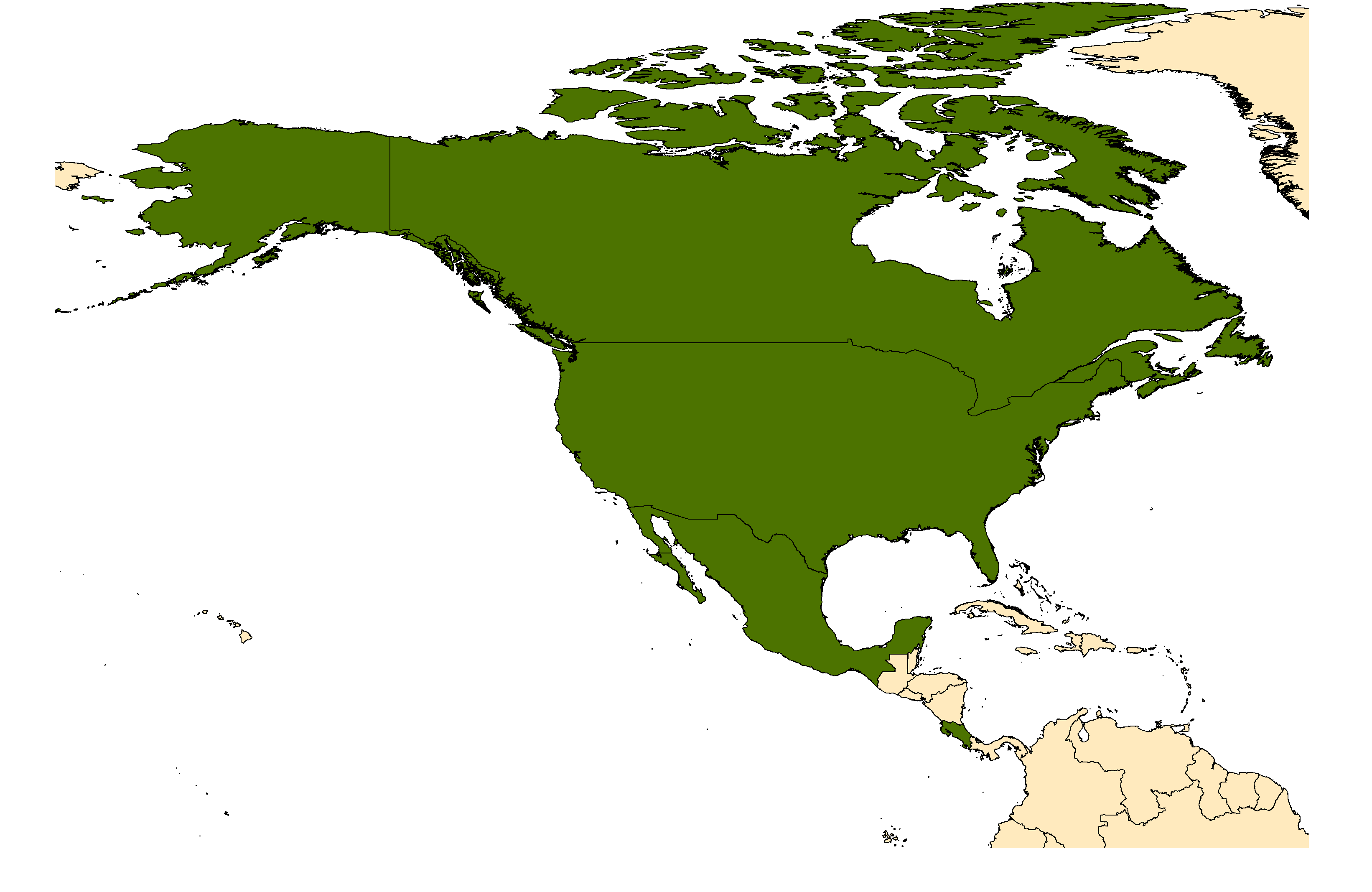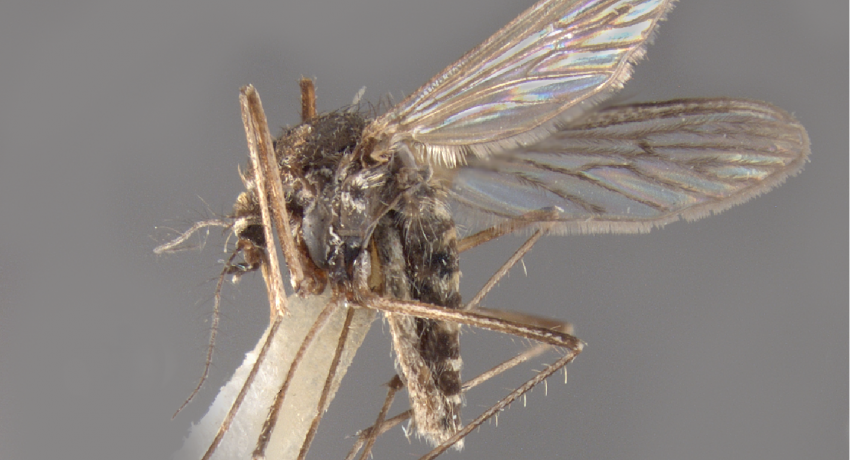NEARCTIC REGION
Etymology: foot (Gr) [probably refers to tarsal claw characters]
Culex tarsalis delivers one of the most painful bites of all mosquitoes. The proboscis has a bright-white median band, and its white leg bands span both sides of each joint. This species stretches from Alaska to Central America, but appears best suited to the arid West.
Type locality: Argus Mountains, California, United States
Type depository: U.S. National Museum, Washington, D.C., United States (USNM)
DIAGNOSTIC CHARACTERS (Click photos to view; mouse over and click large photo to zoom in.)
ADULT (illustrated): Head: Proboscis with broad median pale band; palpus with pale scales. Wing: Scattered pale scales on costal and subcostal veins. Legs: Ta-I–III with distinct white bands, most prominent on Ta-III. Abdomen: Terga with broad basal bands of white or yellowish-white scales; sterna with inverted V-shaped dark markings on each segment.
LARVA (not illustrated): Head: Seta 1-A large, multi-branched, inserted at a constriction on apical third of antenna; setae 5–7-C with ≥3 aciculate branches. Terminal segments: Siphon index 4.5–5.5; seta 1-S usually with five pairs of ventral tufts inserted in straight line; seta 2-X 2,3 branched, shorter than 3-X.
TAXONOMIC KEYS
Carpenter & LaCasse 1955
Dodge 1966
Bohart & Washino 1978
Darsie & Day 2003
Darsie & Ward 2005
Becker et al. 2010
Harrison et al. 2016
Exemplar DNA sequences
Cx. tarsalis COI: MG087219, MG079988, MG079101, KT117301, KR681424, KR695532
BIONOMICS
Immatures
Unlike other North American Culex species, Cx. tarsalis eggs can survive desiccation for short periods of time. Larvae are found in a wide variety of shaded and open sunlit habitats, including ditches, irrigation systems, ground pools, marshes, pools in stream beds, rain barrels, and animal foot prints—particularly those associated with animal corrals and abattoirs. Immature Cx. tarsalis have also been reported at high altitudes—up to 7000ft in the Sierra Nevada Mountains of California and up to 9000ft in the Rocky Mountains, Utah—usually in clear, clean waters, which may indicate cryptic speciation in Cx. tarsalis.
Adults
Culex tarsalis is a highly aggressive day-biter and readily enter buildings seeking blood meals. Opportunistic feeders, host seeking females are strong flyers, covering distances of up to 4km in search of a blood meal. In rural, undeveloped areas, Cx. tarsalis feeds almost exclusively on birds, but feed on cattle, horses and man in agricultural regions. In southern regions the species is present year-round. In temperate zones, Cx. tarsalis is active from late spring to early autumn, and overwinter as females in basements, sheds, cellars and caves. Culex tarsalis is multivoltine and can become locally numerous. Its plastic feeding habits and longevity facilitate zoonotic transmission of pathogens, particularly viral encephalitis, to man.
DISTRIBUTION NOTES
Canada, Mexico, United States (Alaska, continental).

WRBU VECTOR HAZARD REPORTS
None; View other WRBU Vector Hazard Reports
Available GIS Models:
Cx_tarsalis_Dornak_1 North America
IMPORTANT REFERENCES (full citations below)
Coquillett 1896: 43 (M, F)
Ross 1947: 49 (M*, F*, L*)
Yamaguti & LaCasse 1951c: 66 (M*, F*, L*)
Lungstrom 1954: 86 (bionomics)
Carpenter & LaCasse 1955: 294 (M*, F*, L*; keys)
Horsfall 1955: 592 (bionomics, disease relations)
Lungstrom 1955: 68 (P*, L*)
Bohart & Washino 1957: 463 (L*)
Dow et al. 1957: 294 (bionomics, disease relations)
Stone & Knight 1957a: 57 (lectotype designation)
Dodge 1966: 371 (1st instar L*; key)
Bram 1967a: 106 (M*, L)
Bohart & Washino 1978: 130 (M*, F*, L*; keys, taxonomy, bionomics, distribution)
Darsie & Day 2003: 101 (P*; taxonomy, key)
Darsie & Ward 2005 (F*, L*; keys, distribution)
Becker et al. 2010: 398 (F*, L*; key, taxonomy, distribution, bionomics)
Larson et al. 2010 (bionomics)
Harrison et al. 2016 (F*, L*; keys, distribution, taxonomy)
Lutz, et al. 2020 (bionomics)
CURRENT SYNONYMS
syn. willistoni Giles
1900a: 281 (F). Type locality: Argus Mountains, California, United States (USNM). References: Belkin 1968b: 21 (type information).
syn. kelloggii Theobald
1903i: 211 (M, F). Type locality: Stanford University, California, United States (NHMUK). References: Stone 1957a: 341 (lectotype designation); Belkin 1968b: 17 (type information).
CITED REFERENCES
Becker, N., Petrić, D., Zgomba, M., Boase, C., Madon, M., Dahl, C., & Kaiser, A. (2010). Mosquitoes and their control (Second ed.). Berlin Heidelberg: Springer-Verlag.
Belkin, J.N. (1968b). Mosquito studies (Diptera, Culicidae). IX. The type specimens of New World mosquitoes in European museums. Contributions of the American Entomological Institute, 3(4), 1–69.
Bergren, N. A., Borland, E. M., Hartman, D. A., & Kading, R. C. (2021). Laboratory demonstration of the vertical transmission of Rift Valley fever virus by Culex tarsalis mosquitoes. PLOS Neglected Tropical Diseases, 15(3), e0009273.
Bohart, R.M. & Washino, R.K. (1978). Mosquitoes of California (3rd ed.). Berkeley, CA: University of California, Agriculture and Natural Resources.
Bohart, R.M., & Washino, R.K. (1957). Differentiation of second and third stage larvae of California Culex (Diptera: Culicidae). Annals of the Entomological Society of America, 50, 459–463.
Bram, R.A. (1967a). Classification of Culex subgenus Culex in the New World (Diptera: Culicidae). Proceedings of the United States National Museum, 120(3557), 1–122.
Carpenter, S.J., & LaCasse, W.J. (1955). Mosquitoes of North America (North of Mexico). Berkeley, Los Angeles: University of California Press.
Coquillett, D.W. (1896). New Culicidae from North America. Canadian Entomologist, 28, 43–44.
Darsie, R.F., Jr., & Day, J.F. (2003). Studies of the genus Culex Linnaeus in Florida. I. Redescription of the pupae of Culex nigripalpus Theobald and Cx. tarsalis Coquillett, vectors of St. Louis encephalitis, and a key to pupae of Culex species in the Eastern United States (Diptera: Culicidae). Proceedings of the Entomological Society of Washington, 105(1), 100–107.
Darsie, R.F., Jr., & Ward, R.A. (2005). Identification and geographical distribution of the mosquitoes of North America, north of Mexico. Gainesville, FL: University Press of Florida.
Dodge, H. R. (1966). Studies on mosquito larvae II. The first-stage larvae of North American Culicidae and of world Anophelinae. Canadian Entomologist, 98, 337–393.
Dow, R.P., Reeves, W.C., & Bellamy, R.E. (1957). Field tests of avian host preference of Culex tarsalis Coq. American Journal of Tropical Medicine and Hygiene, 6, 294–303.
Giles, G. M. (1900a). A handbook of the gnats or mosquitoes giving the anatomy and life history of the Culicidae. J Bale and Sons and Danielsson, Ltd London.
Harrison, B.A., Byrd, B.D., Sither, C.B., & Whitt, P.B. (2016). The mosquitoes of the Mid-Atlantic Region: an identification guide (Vol. 1). Madison Heights, MI: Publishing XPress.
Horsfall, W.R. (1955). Mosquitoes. Their bionomics and relation to disease. New York, NY: Hafner Publishing Company (Reprinted in 1972).
Larson, S.R., DeGroote, J.P., Bartholomay, L.C., & Sugumaran, R. (2010). Ecological niche modeling of potential West Nile virus vector mosquito species in Iowa. Journal of Insect Science, 10(1), 110.
Lungstrom, L. (1954). Biological studies on Culex tarsalis (Diptera, Culicidae) in Kansas. Transactions of the Kansas Academy of Science, 57, 86–96.
Lungstrom, L. (1955). Additional observations on the recognition features of the Culex tarsalis larva and pupa (Culicidae: Diptera). Transactions of the Kansas Academy of Science, 58, 68–74.
Lutz, E. K., Ha, K. T., & Riffell, J. A. (2020). Distinct navigation behaviors in Aedes, Anopheles and Culex mosquito larvae. Journal of Experimental Biology, 223(7).
Ross, H.H. (1947). The mosquitoes of Illinois (Diptera, Culicidae). Bulletin of the Illinois Natural History Survey, 24(1), 1–96.
Stone, A. (1957a). Corrections in the taxonomy and nomenclature of mosquitoes (Diptera, Culicidae). Proceedings of the Entomological Society of Washington, 58 (1956), 333–344.
Stone, A., & Knight, K.L. (1957a). Type specimens of mosquitoes in the United States National Museum. IV: The genus Culex (Diptera, Culicidae). Journal of the Washington Academy of Sciences, 47(2), 42–59.
Theobald, F.V. (1903i). Description of a new North American Culex. Canadian Entomologist, 35, 211–213.
Yamaguti, S., & La Casse, W. J. (1951c). Mosquito fauna of North America. Part IV. Genera Culex and Deinocerites. Office of the Surgeon General, Headquarters, 8th Army, APO 343. United States. 207th Malaria Survey Detachment.
CITE THIS PAGE
Walter Reed Biosystematics Unit (Year). Culex tarsalis species page. Walter Reed Biosystematics Unit Website, http://wrbu.si.edu/vectorspecies/mosquitoes/tarsalis, accessed on [date (e.g. 03 February 2020) when you last viewed the site].









































































































































































